All posts by Andrea Grant
About Andrea Grant
Andrea Grant is a Children's Services Specialist. View all posts by Andrea Grant →
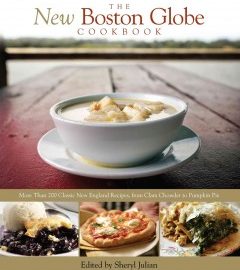
Bibliobites in April: Down-Home Cooking
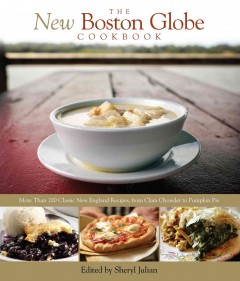 In April our Bibliobites titles usually coordinate with the library’s One Book program, and this year was no exception. Our One Book title, Stronger by Jeff Bauman, features a Chelmsford-raised author and many references to local Chelmsford restaurants and locales. So it seemed appropriate to choose cookbooks that reflect local cuisine, both traditional and innovative.
In April our Bibliobites titles usually coordinate with the library’s One Book program, and this year was no exception. Our One Book title, Stronger by Jeff Bauman, features a Chelmsford-raised author and many references to local Chelmsford restaurants and locales. So it seemed appropriate to choose cookbooks that reflect local cuisine, both traditional and innovative.
As far as Boston-area residents are concerned, there isn’t much that’s more traditional than the Boston Globe newspaper. The first edition of their eponymous cookbook was published in 1948 and was called The Boston Globe Cook Book for Brides (one of our members has this same book in its 1963 incarnation!). The recipes in that first book were sourced from the fondly remembered Confidential Chat column, a reader recipe exchange that appeared in the paper for over 100 years. The book we used was published in 2009, and the recipes are “…culled from the cooks who have been writing for The Boston Globe food pages for the last decade.” As most of us realized in using this book, there was much of the familiar, though there were some welcome new twists.
Among the recipes that drew praise was the vegetarian stuffed winter squash, which is stuffed with a delicious mix of chestnuts and mushrooms. Decreasing the amount of bread stuffing called for, while increasing the quantity of chestnuts made it taste even better! The gingery bok choy was super-simple to make but very flavorful; a keeper! Likewise, the baked sweet potatoes with ginger were so easy, but the combination of the sharp ginger and savory soy sauce on the sweet potatoes was outstanding. The lazy man’s lasagna was praised for being delicious and creamy, as well as quick to make and producing a large amount (excellent for leftovers!). The chicken Provencal had a lovely orange-flavored sauce that really made the dish, and the chicken scallopine with lemon, tomatoes, and capers was also enhanced by its citrus sauce. The fish cakes (a traditional and pedestrian dish if ever there was one) were excellent; they were nice and crunchy on the outside with their panko and bacon topping, and you didn’t have to cook the fish before assembling the cakes. Definitely a keeper! The shrimp scampi limoncello was also tasty, though the limoncello was expensive to buy. This recipe would have fit well into the North End cookbook! And here’s a tip for your “excess” limoncello (should you tire of sipping it): one person lavishly praised the yummy limoncello ricotta cheesecake from Ina Garten’s newest book, Cooking For Jeffrey. The recipe is available on the Food Network’s website here. Other baked goods we tried included the blueberry muffins, which are very close to the iconic Jordan Marsh blueberry muffins. The bittersweet-chocolate brownie cookies were praised for their flavor; they featured plenty of chocolate, and had a nice brownie-like texture. At Easter, one person made the traditional kourambiethes but thought her mother’s recipe was better– of course!
There were some recipes in this book that missed the mark. The mac and ricotta was too dry and really suffered from a lack of creaminess. It was bland, too, since the cheeses it called for were both very mild-flavored. This of course led to a discussion of favorite mac and cheese recipes, with most people agreeing that adding mustard to the sauce is a great way to up the flavor overall. The long-cooked short-rib ragu for pasta was way too greasy; short ribs can have this problem, but the recipe’s method didn’t provide information on how to get around this. The sauce did have good flavor, though. The oven-fried fish was pretty basic, and the fish had that typical problem of having a mushy bottom crust, since that’s what sits directly on the baking sheet. The peanut butter cookies were disappointing; they were dry despite containing plenty of both melted butter and peanut butter.
The group agreed that most of the recipes in this book, while often solid, were nothing special. Most of us felt we already had better recipes for many of the dishes; and after trying the book’s version we weren’t motivated to change! And, the seasonings were generally on the tame side; we wanted recipes that had a little more oomph. But, we felt this might be a good basic cookbook, maybe for someone new to the area who would enjoy an introduction to classic New England foods. Most people liked the layout of this book, though some did not appreciate the “paragraph” (as opposed to “list”) format of the instructions. And, as has been true for other titles, the photograph sometimes didn’t match up to the recipe it illustrated. When it came down to votes, most people gave it a 4 (out of 5); our overall average was 3.63.
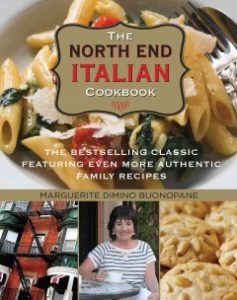 The North End Italian Cookbook has also gone through many editions; the first was published in 1975, and the one we used in 2013. Oddly enough, despite the fame of the North End and its numerous restaurants, most of the group felt nothing really called to them as they perused the pages. The recipes seemed pretty unremarkable, though there were a few hits. The crispy eggplant sandwiches were delicious and easy to make, though it needed some marinara on the side (why does eggplant always need tomato?). The fresh mushroom soffrito was a very tasty vegetable combination with multiple uses– as a pasta sauce, over polenta, in a sandwich– and it kept well. On the other hand, the pasta e fagiole soup’s beans weren’t close to being tender when the recipe said they should be, and the lentil soup was boringly bland as written. It needed some doctoring with cumin and kielbasa! One section of the book that seemed stronger than the others was the dessert chapter, particularly the cookies. Even if we didn’t make any, these recipes sounded delicious. One member brought in some of the Italian sesame seed cookies, and they were molto bene! Everyone also loved the old black-and-white photos in the book and the author’s short vignettes of growing up in the North End. The book also had a nice format, with most recipes on one page. We just wished we liked the recipes themselves better! This ambivalence was reflected in our voting; many did not vote at all since they hadn’t actually cooked anything from the book, and our average worked out to 3.5, which makes it sound better than it really was.
The North End Italian Cookbook has also gone through many editions; the first was published in 1975, and the one we used in 2013. Oddly enough, despite the fame of the North End and its numerous restaurants, most of the group felt nothing really called to them as they perused the pages. The recipes seemed pretty unremarkable, though there were a few hits. The crispy eggplant sandwiches were delicious and easy to make, though it needed some marinara on the side (why does eggplant always need tomato?). The fresh mushroom soffrito was a very tasty vegetable combination with multiple uses– as a pasta sauce, over polenta, in a sandwich– and it kept well. On the other hand, the pasta e fagiole soup’s beans weren’t close to being tender when the recipe said they should be, and the lentil soup was boringly bland as written. It needed some doctoring with cumin and kielbasa! One section of the book that seemed stronger than the others was the dessert chapter, particularly the cookies. Even if we didn’t make any, these recipes sounded delicious. One member brought in some of the Italian sesame seed cookies, and they were molto bene! Everyone also loved the old black-and-white photos in the book and the author’s short vignettes of growing up in the North End. The book also had a nice format, with most recipes on one page. We just wished we liked the recipes themselves better! This ambivalence was reflected in our voting; many did not vote at all since they hadn’t actually cooked anything from the book, and our average worked out to 3.5, which makes it sound better than it really was.
Next month we’re looking to speed things up a bit with Mark Bittman’s How to Cook Everything Fast. This is a giant book but don’t be intimidated! It’s user-friendly and has something for everyone. Bittman also has a website, markbittman.com, if you prefer to try out some of his recipes that way. Copies of the book are available at the main desk; our next meeting will be on Friday May 26 at 11 AM in the Fireplace Room. See you there!
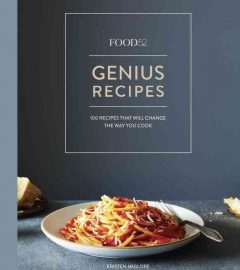
Bibliobites in March: Genius? Maybe!
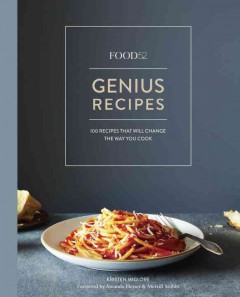 As snow swirled outside, a smallish group met on the last day of March to discuss our experiences with two Food52 titles. Our main book was Food52 Genius Recipes: 100 recipes that will change the way you cook. A few people also checked out Food52 Baking: 60 sensational treats you can pull off in a snap. Both of these titles are, in one way or another , the brainchild of Amanda Hesser and Merrill Stubbs, co-founders of the popular crowd-sourced Food52 website. Their ever-expanding list of titles includes a book of vegan recipes, one on salads, and a forthcoming one about ice cream. With so much experience behind them, do these authors/editors deliver on their promise of “genius,” in changing the way we cook?
As snow swirled outside, a smallish group met on the last day of March to discuss our experiences with two Food52 titles. Our main book was Food52 Genius Recipes: 100 recipes that will change the way you cook. A few people also checked out Food52 Baking: 60 sensational treats you can pull off in a snap. Both of these titles are, in one way or another , the brainchild of Amanda Hesser and Merrill Stubbs, co-founders of the popular crowd-sourced Food52 website. Their ever-expanding list of titles includes a book of vegan recipes, one on salads, and a forthcoming one about ice cream. With so much experience behind them, do these authors/editors deliver on their promise of “genius,” in changing the way we cook?
It turned out that most of us made vegetable-centric recipes from the Genius book. The chickpea stew with saffron, yogurt, and garlic was delicious and different, but it did have a pronounced saffron flavor; so if you don’t like this pricey spice then you won’t like this dish. The radicchio salad with Manchego vinaigrette was also a bit different, and delicious as well. One good tip that appeared in this recipe: to tame the bitterness of radicchio, soak it in ice water for 15 minutes. This did seem to work! Two people tried the potato scallion cakes and thought they were a great use of leftover mashed potatoes, though the potato mixture was on the sloppy side and couldn’t be shaped into patties as described. But it was easy enough to scoop the batter into the pan with a spoon. The green lentil salad was on the bland side; the predominant flavor was vinegar, which wasn’t enjoyable. And the garlic green beans were boringly basic; the cooking technique didn’t elevate them the way the recipe claimed it would. The warm squash and chickpea salad with tahini used some ordinary ingredients, but the sum turned out to be greater than the parts, and this was a delicious and substantial salad. Three people made the gratin of zucchini, rice and onions with cheese; 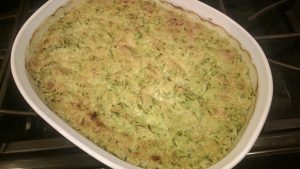 we all agreed it was a yummy dish, but we weren’t sure if it was worth all the fussy extra steps involved in making it. It did make a largish amount, though, so you could definitely eat it more than once. Another tip we picked up from this recipe: a spoonful of raw rice added to soups and sauces will thicken them nicely without contributing obvious flavors. And of course this works best when the resultant dish is one that is pureed. The zucchini gratin used this trick, and the rice did make for a more substantial final product.
we all agreed it was a yummy dish, but we weren’t sure if it was worth all the fussy extra steps involved in making it. It did make a largish amount, though, so you could definitely eat it more than once. Another tip we picked up from this recipe: a spoonful of raw rice added to soups and sauces will thicken them nicely without contributing obvious flavors. And of course this works best when the resultant dish is one that is pureed. The zucchini gratin used this trick, and the rice did make for a more substantial final product.
In the breakfast department, one person tried the poached scrambled eggs, which were very good– tender with no added fat needed. However these also took more work than average to prepare, so you probably wouldn’t make them on a regular basis. The cottage cheese pancakes were a hit– easy to make and “really delicious– these would be great for brunch.” And the roasted applesauce was also simple to make and quite tasty.
Unsurprisingly, there was a lot going on in the dessert department. The dense chocolate loaf cake was, as advertised, very chocolatey; and the flavor improved over a few days’ time. The directions instructed you to add the wet and dry ingredients to the butter/sugar mixture “spoon by spoon” which seemed unnecessarily fussy. Perhaps their spoons are larger than ours? Two of us tried Marie-Helene’s apple cake, with somewhat different results. The recipe called for “four large apples;” and depending on that definition, you could wind up with more or less moisture in your batter, which is important in a recipe that was mostly apples. The consistency of one cake was more like a bread pudding; it was moist and delicious with lots of apple flavor, but not a cake in the usual sense of the word. Smaller apples produced something more cake-like. This concept might be fun to tinker with, but it would have been helpful had the recipe given weight or volume for the apples.
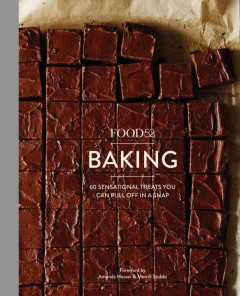 Staying with the dessert theme, but shifting to another book, those who used the Food52 Baking title were highly satisfied with it. The double layer coconut pecan bars were awesome, and a big hit with “Mr. Fussy,” who, it is claimed, does not like coconut. The cold oven pound cake was “to die for,” and the tomato soup cake tasted like a spice cake, with the secret ingredient completely incognito. The lemon sponge cups were fantastic, and brought back good memories of our member’s mom’s lemon sponge pie. The cream cheese cookies were “OK,” but when brought to a meeting they quickly disappeared, to rave reviews. The chocolate banana bread was good, though it took much longer to bake than the directions indicated, and wasn’t exciting enough to tempt our member away from her usual banana bread recipe. The easy as pie apple cake suffered a similar fate, being good but not outstandingly better than other recipes. The cheese crispettes, though savory (not sweet) were excellent– crispy and cheesy and just the thing for serving with drinks. Easy to make, too.
Staying with the dessert theme, but shifting to another book, those who used the Food52 Baking title were highly satisfied with it. The double layer coconut pecan bars were awesome, and a big hit with “Mr. Fussy,” who, it is claimed, does not like coconut. The cold oven pound cake was “to die for,” and the tomato soup cake tasted like a spice cake, with the secret ingredient completely incognito. The lemon sponge cups were fantastic, and brought back good memories of our member’s mom’s lemon sponge pie. The cream cheese cookies were “OK,” but when brought to a meeting they quickly disappeared, to rave reviews. The chocolate banana bread was good, though it took much longer to bake than the directions indicated, and wasn’t exciting enough to tempt our member away from her usual banana bread recipe. The easy as pie apple cake suffered a similar fate, being good but not outstandingly better than other recipes. The cheese crispettes, though savory (not sweet) were excellent– crispy and cheesy and just the thing for serving with drinks. Easy to make, too.
The books themselves are both large format, about the size of a sheet of paper, which seems to have become the standard size for new cookbooks. As is also true of most newer books, there were many luscious photos, and some showed a recipe’s entire sequence from ingredients to finished product. There were a few complaints– some recipes had directions that were unnecessarily wordy, to the point where you had to read them two or three times to get at the actual meaning. And measurements could be inconsistent; sometimes an ingredient would be listed by weight, sometimes by volume, and sometimes in random fashion (see “four large apples” above!). In these books, the recipes come from many sources, so perhaps that explains the different measurement units, but we felt the editors should have standardized things to make it simpler. A few of us checked out the Food52 website and weren’t terribly impressed. The way it was organized didn’t seem user-friendly, and there’s a lot going on visually, which can get annoying. The search function is also kind of fussy– I was looking for the recipe for soft chocolate cherry almond cookies, and I typed “chocolate chip cherry cookies” (and the recipe does have chocolate chips in it)– and I got zero hits! It took a bit of fiddling to figure out how to find what I was looking for. However those cookies are really, really good!
We must have been distracted by the snow piling up outside, or our conversation– because we forgot to vote! But judging from our discussion, I’d guess the baking book would score near a 5 (the top rating), and the Genius book maybe a 3.5. We’ll have a retrospective vote at our next meeting, and I’ll post the results here.
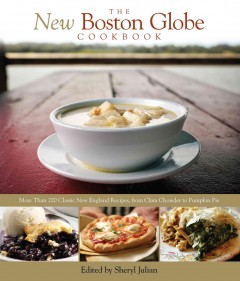
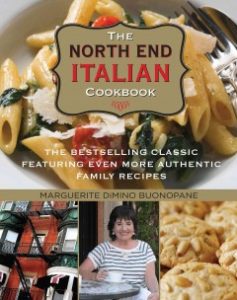 Next month’s titles will coordinate with our One Book title, Stronger, by Chelmsford native Jeff Bauman. We’re focusing on Boston and New England with The New Boston Globe Cookbook and The North End Italian Cookbook. Copies are available at the main desk. Please join us for our next meeting on Friday, April 28 at 11 AM in the Fireplace Room. All are welcome; see you there!
Next month’s titles will coordinate with our One Book title, Stronger, by Chelmsford native Jeff Bauman. We’re focusing on Boston and New England with The New Boston Globe Cookbook and The North End Italian Cookbook. Copies are available at the main desk. Please join us for our next meeting on Friday, April 28 at 11 AM in the Fireplace Room. All are welcome; see you there!
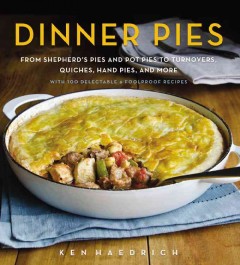
Bibliobites in February: Pie: It’s What’s For Dinner
Do you, like author Ken Haedrich, have a “lust for crust”? As our Bibliobites group discovered through this month’s title, pie crust (and its cousins) isn’t just for dessert anymore– it’s for pot pies, galettes, quiches, strudels, handpies, and tarts. Many of these dishes are familiar cold-weather favorites, but this book introduces some variations we’d never seen, as well as twists on tried-and-true favorites. But the common thread is, of course, the crust; and this topic made for an active discussion!
As it turns out, some in the group are not fond of pie crust at all. How can this be?? Some do not enjoy making the crust, with all its fussy details (more on that in a moment), and some thought the most frequently used crust in the book (the “go-to pie dough”) had too much fat in general, and too much butter in particular. Many of the recipes contained cream, cheese, or sausage; and adding pie crust to this mix just seemed to put the whole dish over the top in terms of fat and calories. Many of the pot pie and shepherd’s pie recipes called for both a top and bottom crust, which some thought was the “correct” way, and some felt was overkill, as they prefer only a top crust.
The details of making the pie crust sent some of us over the edge. In his zeal to demystify crust-making, author Haedrich is very, very specific about how to treat both the ingredients and the mixing process. Perhaps that is why he is known as the “Dean” of The Pie Academy. There are many steps and multiple pauses to chill the dough at various stages, which meant you had to set aside a fair amount of time to complete everything. For some of us, the precise instructions increased anxiety, rather than giving us confidence; we worried that forgetting one part of a step or mistiming another would lead to disaster. The overall methodology was a bit odd for those of us with prior pie crust experience, and the author didn’t explain why he made certain recommendations. We weren’t sure if the extra attention to detail made a noticeable difference in the final product.
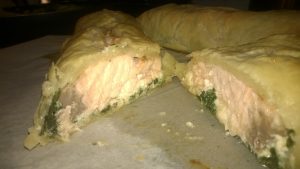
But we did make lots of pies! Among the ones we tried were the old-fashioned chicken and biscuits, which was solidly good but time-consuming and made lots of dirty dishes. But more than one person commented that the biscuits were “to die for!” The turkey crumb pot pie had a topping made of crushed stuffing mix and french-fried onions, which was delicious and easier than making a crust; though the recipe called for a bottom crust, it was omitted for the sake of speed. The meatloaf wellington was a bit of a pain to make– it was hard to wrap the crust completely around the meatloaf, and of course the crust beneath the meatloaf stayed mushy. The meatloaf itself was good but not outstanding, so overall it didn’t seem worth the trouble or the calories! The tarte choucroute was different and delicious; but as with many of these recipes, you needed a lot of lead time to make, chill, and par-bake the crust. And the filling also needed to be cooked ahead and cooled before final assembly. The savory winter vegetable crisp had a cracker-crumb crust that was fairly simple to make; the vegetable combination was enjoyable and it made a large quantity. The downside– it took a long time to prepare, so dinner was much later than desired! The sausage and Guinness pot pie was requested by “Mr. Fussy,” and despite the cook’s doubts about the combination of ingredients, they both loved it. Whew! Three galettes that we enjoyed were the sweet potato and herb Parmesan, the kale, potato, and ricotta, and the curried winter squash. The smoky bacon and cheddar cheese quiche and the shepherd’s pie both suffered from having a not-quite-done bottom crust, despite faithful adherence to par-baking instructions.

Not to be deterred, when our intrepid cook next made the fresh corn pudding pie she “baked the hell out of the crust” before filling it, and this worked better. All three pies were tasty, though. We tried a couple of hand pies too: the Cornish meat pies and the chicken, broccoli, and cheddar turnovers were good and hearty. And the tempeh and brown rice empanadas were successful, too; they were made with a wrapper of pizza dough rather than the called-for pie crust!

The taco pot pie had a crust with some cornmeal in it, which was pleasantly different; it made a large casserole so it was fortunate that it was tasty! One member “went rogue” and found her own recipe for a spinach pie seasoned with sumac; it had a yeasted crust. Sounds good, and similar to this recipe?
The book itself was praised for its beautiful and numerous photographs; and as always, we like when the book stays open on the counter, as this one did. While recipe instructions could sometimes be overly detailed, they usually resulted in a successful product. We enjoyed reading the text; author Haedrich has a distinctive “voice” that always sounds friendly and down-to-earth; we could see ourselves enjoying a conversation with him about almost anything. If we sat down with him, here’s what we’d like him to know: “Ken, your pies are great– they make a lot of solidly good food and are perfect when you’re in the mood for some comfort food and have an afternoon to give to a cooking project. We could do with some quicker choices for a weeknight, though, and– enough with the crust already! We don’t really share your obsession, though we appreciate your quest for perfection.”
In the end we agreed that this book had some delicious choices; it’s just not a title that’s very practical for everyday cooking, and if you don’t care for pie crust then definitely don’t bother with this book. The majority of our group members gave this book 4 chef’s hats (out of a possible 5); but the overall average was 3.5, reflecting some “crust ambivalence.”
If you’d like to explore other Ken Haedrich cookbooks, he has written on everything from soup to vegetarian cooking to simple desserts. Check out the titles available here.
Next month’s title is Food52 Genius Recipes; copies are available at the main desk. We’ll next meet on March 31 at 11 AM in the Fireplace Room. Happy cooking!
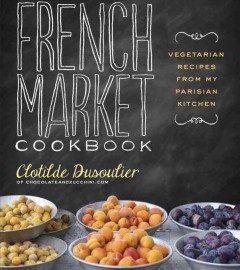
Bibliobites in January: Just Say “Non!”
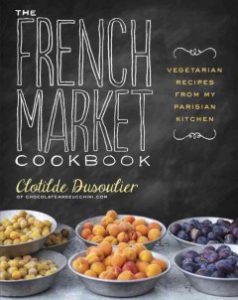 French cooking has (despite Julia Child’s efforts) a reputation for being complicated, fussy, and maybe a bit pretentious. It’s a cuisine famed for its reliance on butter, cream, and rich sauces. Traditionally it’s a meat-centric cuisine as well, with vegetables being little more than an afterthought. Well-known food blogger Clotilde Dusoulier, author of the January Bibliobites selection, aims to show us that modern French cooking is also vegetarian and straightforward. With the excesses of the holidays behind us, this book would seem to be the perfect way to welcome in a new year of healthier eating based on grains, legumes, and seasonal produce. As always, the group had strong opinions about their experience at the French Market.
French cooking has (despite Julia Child’s efforts) a reputation for being complicated, fussy, and maybe a bit pretentious. It’s a cuisine famed for its reliance on butter, cream, and rich sauces. Traditionally it’s a meat-centric cuisine as well, with vegetables being little more than an afterthought. Well-known food blogger Clotilde Dusoulier, author of the January Bibliobites selection, aims to show us that modern French cooking is also vegetarian and straightforward. With the excesses of the holidays behind us, this book would seem to be the perfect way to welcome in a new year of healthier eating based on grains, legumes, and seasonal produce. As always, the group had strong opinions about their experience at the French Market.
……And those opinions were strongly negative! There wasn’t a person at the meeting who enjoyed the book, with most actively disliking it. More than a few people wound up making none of the recipes. The most common complaints were that “nothing called to me,” and that the author frequently used ingredients that are difficult to find in the U.S. (the author is French but has lived in the U.S. and the book is written for an American audience). Par example, she uses spelt berries, rolled barley, lemon verbena leaves, chestnut flour, and celery root, all of which are not readily available. Another common criticism was that the recipes are on the bland side and/or have odd (or should we say unusual?) spicing. For instance, the only flavor in the otherwise very neutral lentil croquettes was a teaspoon of coriander, which was overpowering, with nothing else to balance it out.
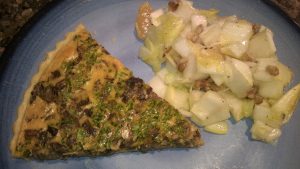
Other recipes that we tried included the cauliflower gratin with turmeric and hazelnuts, which was good but used enough turmeric to make the sauce “neon”! The couscous with vegetables was ordinary, with a few people commenting that they already had similar, and better, recipes for this dish. The softly spiced carrot and almond soup tasted very strongly of cardamom and anise but still seemed like it was missing something; and the butternut and celery root soup was “OK but not outstanding– and I have other squash soup recipes that I like better.” The blanch-roasted new potatoes were a two-step process, as the name implies, but the difference in taste or texture was negligible, and therefore not worth the extra effort. The mushroom and chive quiche was heavy on the mushrooms, which made it unexpectedly expensive; it tasted good but didn’t have that smooth custardy texture we were looking for. The above- mentioned lentil croquettes also lost points for being a bit tricky to assemble; the lentils had little to bind them and tended to fall apart. The tahini sauce that accompanied them was delicious, though.
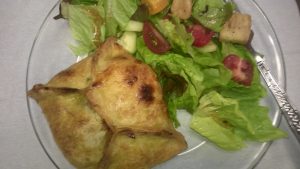
Some of the more successful recipes (in our opinion) included savory pumpkin and cornmeal quick bread, leeks vinaigrette, and endive, orange, and walnut salad. The green bean, red rice, and almond salad, was “good– but I used brown rice because I had it;” the goat cheese and rosemary sables were tasty but the texture was unexpectedly soft– “I wish they were crunchier, more like crackers.” The Corsican turnovers with winter squash were “good but not great,” though they scored points for cuteness and portability.
The book itself, also came in for some critical comments: the format was too small for most people, and there weren’t enough photos. Some of the recipes had unnecessary steps, or it was unclear why those steps were needed. But of course these complaints would have disappeared had everyone enjoyed the food! So, nous sommes désolés (we’re sorry) Clotilde– as far as we’re concerned your book just doesn’t make the grade; our vote yielded an average of 1.625 chef’s hats (out of a possible 5). Mon Dieu!
 Join us when we meet again on Friday, February 24 at 11 AM in the Fireplace Room. This month’s title is Dinner Pies by Ken Haedrich. You still have a week to try out recipes! Copies are available at the main desk.
Join us when we meet again on Friday, February 24 at 11 AM in the Fireplace Room. This month’s title is Dinner Pies by Ken Haedrich. You still have a week to try out recipes! Copies are available at the main desk.
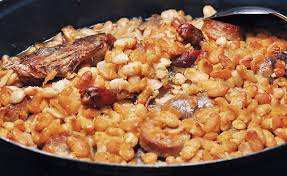
Qu’est-ce que c’est?
 Every year in January, after the rush of the holidays is over and we settle into some real winter, I spend a day making cassoulet. This iconic French dish is a hearty casserole of meat, beans, and some token vegetables, cooked with wine and tomatoes and topped with buttery croutons. It’s the perfect antidote to a raw winter day, and like many stews tastes even better left over. But it is kind of an all-day affair; beans must be soaked, meats must be cut up and browned, and then everything is assembled and baked. I usually use a recipe from the Cook’s Illustrated website, which mostly uses common ingredients we can find in any supermarket.
Every year in January, after the rush of the holidays is over and we settle into some real winter, I spend a day making cassoulet. This iconic French dish is a hearty casserole of meat, beans, and some token vegetables, cooked with wine and tomatoes and topped with buttery croutons. It’s the perfect antidote to a raw winter day, and like many stews tastes even better left over. But it is kind of an all-day affair; beans must be soaked, meats must be cut up and browned, and then everything is assembled and baked. I usually use a recipe from the Cook’s Illustrated website, which mostly uses common ingredients we can find in any supermarket.
HOWEVER…while most large supermarkets now carry an astonishing array of Asian, Italian, or Middle Eastern ingredients, French-specific items seem to have fallen by the wayside—if they were ever available in the first place. Par example, every year I go on a quest to find the beans traditionally used in cassoulet, which are called flageolet.  They are smallish, oval, pale-green beans that I’ve discovered can be difficult to find locally (yes I know I can order them on Amazon, but what fun is that?). The readily-available Great Northern bean is a passable substitute, but hey—if I’m only doing this once a year I want to be authentic about it. In past years I’ve seen flageolet at Whole Foods but no luck this year. Market Basket, Hannaford, and Wegmans were also a no-go. Finally I remembered that Idylwilde Farms in Acton carries some less-common grocery items, and—yes! There they were, sitting placidly on the shelf with all the other dried beans. Interestingly enough they were grown in Maine!
They are smallish, oval, pale-green beans that I’ve discovered can be difficult to find locally (yes I know I can order them on Amazon, but what fun is that?). The readily-available Great Northern bean is a passable substitute, but hey—if I’m only doing this once a year I want to be authentic about it. In past years I’ve seen flageolet at Whole Foods but no luck this year. Market Basket, Hannaford, and Wegmans were also a no-go. Finally I remembered that Idylwilde Farms in Acton carries some less-common grocery items, and—yes! There they were, sitting placidly on the shelf with all the other dried beans. Interestingly enough they were grown in Maine!
Another traditional ingredient used in cassoulet, which seems to be on every bistro menu in France but is rarely seen here, is duck confit.  This is a duck leg which has been cooked in and then covered with duck fat, a pre-refrigeration method of preserving meat. The confit can be eaten by itself or added to main-dish salads or casseroles, where it adds richness and flavor. But in the US this is definitely a specialty item; I did find it at Wegmans but c’est tres cher (it’s very expensive!). In my duck-buying expeditions I discovered that any form of duck, whether fresh, frozen, or otherwise preserved, is not widely sold in supermarkets. Whereas in France, again, it is on every restaurant menu in some form, and probably in every market as well. It’s a curious cultural difference!
This is a duck leg which has been cooked in and then covered with duck fat, a pre-refrigeration method of preserving meat. The confit can be eaten by itself or added to main-dish salads or casseroles, where it adds richness and flavor. But in the US this is definitely a specialty item; I did find it at Wegmans but c’est tres cher (it’s very expensive!). In my duck-buying expeditions I discovered that any form of duck, whether fresh, frozen, or otherwise preserved, is not widely sold in supermarkets. Whereas in France, again, it is on every restaurant menu in some form, and probably in every market as well. It’s a curious cultural difference!
So, flageolet—check! Duck confit—check! The cassoulet ingredients were cooked, assembled, and went into the oven. What to eat with it? A green salad immediately came to mind, but being in a “difficult French ingredient” mode I had decided to make celeri remoulade, a salad made of grated celeriac (or celery root).  Our Bibliobites book for this month, The French Market Cookbook by Clotilde Dusoulier, has a few recipes that use this root vegetable. So by now I know who sometimes carries it. It’s available in many supermarkets, but is ordered infrequently and in small quantity, so it’s hit-or-miss as to whether you’ll find it on any given visit. Again, this is a very common ingredient in France and all of northern Europe. I often wonder if celeriac will be the next cauliflower—that is, an ingredient which has been around forever, sort of in the background, and suddenly becomes a produce superstar. Celeriac is a knobby white root vegetable that looks sort of like a hairy turnip. It has a mild taste, celery-ish with hints of anise, and a texture similar to a turnip’s. Dusoulier’s book has a recipe for a potato/celeriac gratin which was delicious. The celery root lightens the dish a bit and adds a subtle, welcome flavor.
Our Bibliobites book for this month, The French Market Cookbook by Clotilde Dusoulier, has a few recipes that use this root vegetable. So by now I know who sometimes carries it. It’s available in many supermarkets, but is ordered infrequently and in small quantity, so it’s hit-or-miss as to whether you’ll find it on any given visit. Again, this is a very common ingredient in France and all of northern Europe. I often wonder if celeriac will be the next cauliflower—that is, an ingredient which has been around forever, sort of in the background, and suddenly becomes a produce superstar. Celeriac is a knobby white root vegetable that looks sort of like a hairy turnip. It has a mild taste, celery-ish with hints of anise, and a texture similar to a turnip’s. Dusoulier’s book has a recipe for a potato/celeriac gratin which was delicious. The celery root lightens the dish a bit and adds a subtle, welcome flavor.
As for my salad, predictably enough, the day I needed the celeriac there was none to be found on the shelf at Wegmans. C’est la vie! I wasn’t in the mood to hunt it down elsewhere so we enjoyed our cassoulet with a green salad after all. It was delicious, if I do say so myself; so as Julia Child would say—Bon Appetit!
For those of you who belong to our Bibliobites group, have you been enjoying your French Market adventure? Whether oui or non, please join us for our next Bibliobites meeting on Friday, January 27 at 11 AM in the Fireplace Room.
For those of you who have yet to discover our cookbook group, ce n’est pas grave! — we meet the last Friday of every month. Join us!

I’ve Never Been to Italy…..
 …..but I have been to Eataly! This gastronomic temple of all things Italian opened in Boston two weeks ago. It’s the newest outpost of this global enterprise, and one of only four in the US. I’d been to Eataly in Manhattan and was excited to check out our local store, located in the Prudential Center. All in the name of BiblioBites research, of course; inquiring minds always want to know about the latest new thing in the Boston food scene!
…..but I have been to Eataly! This gastronomic temple of all things Italian opened in Boston two weeks ago. It’s the newest outpost of this global enterprise, and one of only four in the US. I’d been to Eataly in Manhattan and was excited to check out our local store, located in the Prudential Center. All in the name of BiblioBites research, of course; inquiring minds always want to know about the latest new thing in the Boston food scene!
Eataly was conceptualized and founded in Torino, Italy in 2007 by Oscar Farinetti, who wanted to make top-quality Italian food accessible to all in a European open-market style. His main collaborators in this enterprise are celebrity chefs Mario Batali and Lidia Bastianich, who shepherded the opening of the Boston store. (Check out their latest titles: Batali’s Mario Batali Big American Cookbook; Bastianich’s Lidia’s Mastering the Art of Italian Cuisine). One of Eataly’s prime directives is “eat, shop, learn,” and certainly it’s easy enough to do all three on any given visit.
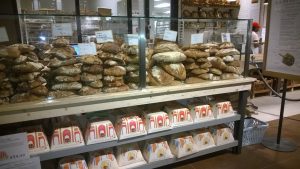 The Boston store is about half the size of the NYC store, but this is a good thing! It’s much less overwhelming, though the aisles are maze-like and can be difficult to negotiate when it’s crowded. Shelves of specialty items are crammed next to cases laden with cheese, salami, fresh pasta, foccaccia, gelato, and more. If you want a snack there are two espresso bars, a cannoli cart (unique to the Boston store), pastry counter, and a crepe stand. And should you need lunch or dinner, fear not. You have multiple options for takeout and sit-down meals. For the latter, there’s La Pesce for fish, La Pizza e la Pasta for– pizza and pasta, and in the center of it all, La Piazza, a bar-like area serving drinks and small plates. For takeout there’s an area devoted to salads hot and cold, vegetables, risotto, roasted meats….it goes on! Takeout pizza is coming soon, as is a more formal restaurant on the third floor.
The Boston store is about half the size of the NYC store, but this is a good thing! It’s much less overwhelming, though the aisles are maze-like and can be difficult to negotiate when it’s crowded. Shelves of specialty items are crammed next to cases laden with cheese, salami, fresh pasta, foccaccia, gelato, and more. If you want a snack there are two espresso bars, a cannoli cart (unique to the Boston store), pastry counter, and a crepe stand. And should you need lunch or dinner, fear not. You have multiple options for takeout and sit-down meals. For the latter, there’s La Pesce for fish, La Pizza e la Pasta for– pizza and pasta, and in the center of it all, La Piazza, a bar-like area serving drinks and small plates. For takeout there’s an area devoted to salads hot and cold, vegetables, risotto, roasted meats….it goes on! Takeout pizza is coming soon, as is a more formal restaurant on the third floor.
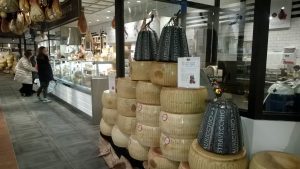 While there I lunched on a prosciutto, fresh mozzarella, and arugula panini. One of the stated goals of Eataly is to source and sell high-quality ingredients, and the panini certainly illustrated that; the prosciutto was tender and not too salty, the mozzarella fresh and milky, and the bread toothsome and flavorful. To go with my sandwich, there were house-made ultra-thin potato chips, which were so perfectly light and salty (think Lays on steroids) that I couldn’t stop eating them. I tried coffee at both of the espresso bars– Lavazza and Illy– I preferred the Illy. The coffee was surprisingly, screamingly hot, which I wasn’t expecting. After I got over the shock, I did appreciate it, since I usually think that most coffee isn’t hot enough.
While there I lunched on a prosciutto, fresh mozzarella, and arugula panini. One of the stated goals of Eataly is to source and sell high-quality ingredients, and the panini certainly illustrated that; the prosciutto was tender and not too salty, the mozzarella fresh and milky, and the bread toothsome and flavorful. To go with my sandwich, there were house-made ultra-thin potato chips, which were so perfectly light and salty (think Lays on steroids) that I couldn’t stop eating them. I tried coffee at both of the espresso bars– Lavazza and Illy– I preferred the Illy. The coffee was surprisingly, screamingly hot, which I wasn’t expecting. After I got over the shock, I did appreciate it, since I usually think that most coffee isn’t hot enough.
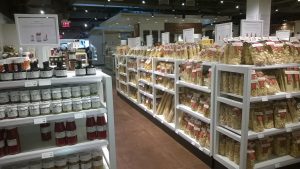 One of Italy’s main claims to culinary fame is its endless variety of pasta, and here Eataly does not disappoint. There are at least twelve brands of dried pasta represented, from artisan varieties costing $7 or $8 per pound, to the familiar blue-boxed Barilla. Pasta is sold in every conceivable shape; whole-wheat and other flours are also represented. To go with your pasta there are several types of jarred sauce (tomato-based or pesto) and multitudinous varieties of olive oil.
One of Italy’s main claims to culinary fame is its endless variety of pasta, and here Eataly does not disappoint. There are at least twelve brands of dried pasta represented, from artisan varieties costing $7 or $8 per pound, to the familiar blue-boxed Barilla. Pasta is sold in every conceivable shape; whole-wheat and other flours are also represented. To go with your pasta there are several types of jarred sauce (tomato-based or pesto) and multitudinous varieties of olive oil.
If you’re not in the mood for pasta (is that possible?), there are ten or so kinds of risotto, and at least four styles of polenta. Or, if it’s appetizers you need, in addition to the aforementioned cheese and salami there are olives galore, semi-dried tomatoes, breadsticks, and pickles of various sorts. And don’t forget the sweets: chocolates, cookies, and (since it’s Christmastime), several varieties of panettone.
After wandering about for an hour or so, I was on sensory overload, and managed to miss the wine shop. Next time! There’s also La Scuola, where you can take a food or wine class. In viewing the schedule, classes range in price from $10 to $150, but the vast majority are sold out through the end of February, the latest date shown online.
If you love Italian food, Eataly is absolutely worth the trip, but choose your day and time carefully! My first visit was on a weekday morning; I arrived around 9:45 AM and pretty much had the place to myself, as you can see from the photos. By 11 AM or so things were hopping and it was difficult to move in some of the aisles. Lunch around noon entailed a wait, but it was only about 5 minutes. However by 12:30 the lines were considerably longer. On a second brief visit on a Saturday evening, it was so crowded I could barely walk anywhere. The line for panini stretched outside the store, and all the other stations were similarly busy. Eventually the novelty will wear off and the crowds thin out, but for now I’d advise a weekday expedition; and remember to bring your patience. One oddity of Eataly’s layout is that you pay for any fresh food at the counter where you buy it, but boxed and jarred items are paid for at a set of registers near the exit. So depending on what you buy, you could wind up standing in several lines before you finally emerge with your bounty!

Bibliobites in December: Baker’s Dozen
Our combined November/December Bibliobites meeting on December 2nd covered numerous topics, in addition to discussing this month’s titles. Something about the subject of cookies, and taste-testing brownies (more on that in a moment!) seemed to bring out lots of opinions about baking, cookbooks, and more. It was a lively and enjoyable discussion!
Our first order of business was a “Brownie Smackdown.” Although this is a group that loves to cook, occasionally even we may resort to a mix of one sort or another. Brownie mixes are ubiquitous and come in so many varieties– are there any that can come close to homemade? We tried four brands: Betty Crocker, Duncan Heinz, Ghirardelli and Pillsbury Purely Simple. All were a basic dark chocolate variety (no frosting, or extra fudge) baked according to package directions, and no one tasting them knew which was which. Group members ranked them from one to four, with one being the best. So the lower the overall score, the better. Our final tally:
- Betty Crocker: 15 points
- Pillsbury Purely Simple: 18 points
- Ghirardelli: 20 points
- Duncan Heinz: 27 points
Both the Betty Crocker and the Pillsbury were less familiar to the group overall (that is, fewer people had tried them); and, as is the case with most food items, people had strong preferences which influenced their ratings. There’s always the fudgy vs. cakey camp, for one; also soft vs. chewy and bold chocolate flavor vs. more subtle. Duncan Heinz had the least chocolate flavor, with more than one person commenting that they had no chocolate flavor at all! They were also deemed too soft and wet. So, sorry Duncan Heinz– you’re at the bottom of the pack. The other three were definitely tastier and more chocolatey, and each had its advocate. Would we buy these instead of making homemade? Most insisted that brownies are so easy to make from scratch that there’s no reason to ever buy a mix, especially when homemade tastes better. A mix can be handy on a day when you’re pressed for time and don’t want to think about pulling out ingredients, but this group wasn’t totally convinced that it was worth it.
As a side note, after the tasting we wondered if the order in which the products were tasted influenced how they were rated. Interestingly, the Betty Crocker was the first one most tried– and that came out on top. Later a few of us tried some of the brownies in different order, and it always seemed like the first one had the best chocolate flavor (except for Duncan Heinz– sorry DH!). So OK, we’re not pros at the taste-testing game (maybe next time we should spit and rinse, like a wine tasting?), but we learned a little and got to eat some brownies, too. Readers, have you used a mix that you think is as good as a from-scratch product? Let us know and we’ll publish a list.
Some people commented that brownies were one of the first things they learned to bake, and that sparked a discussion of cookbooks used when we were growing up. Many had fond memories of Betty Crocker’s Cook Book For Boys and Girls, 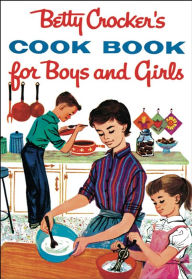 initially published in 1957. From there we wondered what was everyone’s “go-to” cookbook– what do you consult when you want information and/or a foolproof recipe? Unsurprisingly, the internet received plenty of votes; but one’s own family recipe box was also mentioned by several people. Other Betty Crocker titles, books published by Good Housekeeping, and America’s Test Kitchen Best Recipe were praised as well. As with so much else related to cooking, it’s a highly personal choice!
initially published in 1957. From there we wondered what was everyone’s “go-to” cookbook– what do you consult when you want information and/or a foolproof recipe? Unsurprisingly, the internet received plenty of votes; but one’s own family recipe box was also mentioned by several people. Other Betty Crocker titles, books published by Good Housekeeping, and America’s Test Kitchen Best Recipe were praised as well. As with so much else related to cooking, it’s a highly personal choice!
Moving on to our cookie discussion, it seemed there was a lot of recipe reading that went on, but not so much baking. We enjoyed perusing both books and at least marking recipes we wanted to try— later! I did ultimately bake the vegan ginger cookies and the date-fig nut bites from Crazy About Cookies— and both were excellent. The ginger cookies were soft and chewy with plenty of spice, and the date-fig cookies were cakey and fruity; kind a high-class Fig Newton. From Chewy Gooey Crispy Crunchy, one person made the ultra-thin chocolate chip cookies, which were crispy yet sturdy, with classic chocolate-chip cookie flavor. Another praised the French macarons recipe, which had lots of specific information that ensured success. Author Alice Medrich, well-known for her multiple chocolate-themed cookbooks, includes many helpful general tips, such as always resting your cookie dough in the fridge before baking. She also provides ideas for you to go beyond her basic recipe and make it your own.
On the savory side of things, we also perused Martha Stewart’s Appetizers. As with the cookie books, there was more reading than doing! We really liked the layout of this book; each page had a recipe and several variations, with photos. It was clear and easy to read, and the book stayed open when laid on the counter. Complaints included a poor index, and too many recipes that required deep-frying. One person tried the pistachio-stuffed dates, which were delicious and led to a short discussion of all the yummy ways you could stuff a date! Another person enjoyed the kale and fontina stuffed mushrooms despite the sauce being a bit too thin for their liking. There was an “epic failure” with the roasted spiced chickpeas which just refused to become crisp. Other members had tried similar recipes with success, so we weren’t sure exactly what the problem was– possibly too much oil in the pan? In general, everyone had a favorable impression of this book; most of the recipes seemed appealingly easy and sounded, well, appetizing! It’s a user-friendly successor to Martha Stewart’s Hors D’oeuvres, which many remembered well from the 1980s.
Our cookie discussion at one point brought up hermits, an old-fashioned cookie that is certainly still enjoyed today. As always, there were definite opinions on what this cookie should contain (most include nuts, others don’t), and how it should be made (in a long bar that is cut into cookies after baking). Decades ago I clipped this recipe from the fondly-remembered Confidential Chat column in the Boston Globe. It was submitted by a contributor known as The Cantabridgian. They are delicious!
Hermits
3/4 to 1 cup shortening
1 1/2 cups sugar
1/2 cup molasses
2 beaten eggs
3 1/2 cups flour
1/2 to 3/4 cup chopped raisins
3/4 to 1 cup chopped walnuts
1 teaspoon salt
1/2 teaspoon baking soda
1 teaspoon cinnamon
1/2 teaspoon each: ground cloves, mace, ginger, nutmeg
Cream the shortening and sugar in a large bowl. Add molasses and eggs, then add flour slowly with all other dry ingredients. Add raisins and nuts and mix until combined. The batter will be stiff; if it seems dry add a little water.
Spread about 3 cups of batter on parchment or a greased cookie sheet. The batter should be a long, thin oblong about 1/2″ thick. (If you have a wide cookie sheet you can fit 2 oblongs on one sheet). Bake at 350 for 10-12 minutes, or until cookie tops almost spring back when pressed with a fingertip. Let cookies cool on sheet for 5-7 minutes, then cut across on the diagonal about 2 inches wide. Cool on rack; repeat process with remaining batter. Makes 4-5 dozen. Enjoy!
Whichever December holidays you celebrate, may they be filled with generous helpings of family, friends, and of course– fabulous food! We will meet again on Friday, January 27 at 11 AM in the Fireplace Room. To counteract all those holiday treats, we will be cooking lots of vegetables from Clotilde Dusoulier’s The French Market Cookbook. Copies are available at the front desk. Bon appetit!
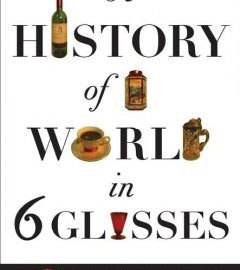
Bibliobites in October: We’ll Drink to That?
When you enjoy a glass of wine with your dinner, do you ever ponder its provenance? When you uncap a cold beer on a hot summer day, have you ever wondered how brewing got started? Many of us can’t imagine a day without that trio of caffeinated drinks: coffee, tea, and Coke; but where and when did they originate? We discovered this month that many common beverages have a long and checkered past. Since the beginnings of humanity, people have had to settle where there was water; but other drinks have also shaped history in prominent and surprising ways. This month’s title, A History of the World in 6 Glasses, views its namesake drinks through the lens of politics, culture, religion, and more.
If you’re thinking right now that this all seems pretty weighty for a cup of coffee or a Coke– our group would agree with that. While most found the history “interesting,” there was a bit too much information, particularly in the earlier chapters, which focus on beer and wine. We recognized that these drinks have centuries of history to explore, and author Tom Standage provides a detailed, almost academic treatise of his subject. Some felt his writing was just too dry for their taste (like some wines?), though we did enjoy the numerous anecdotes sprinkled throughout. Here’s one factoid to mention at your next workshop or conference: the word symposium comes from the Greek symposion, which means a ritual drinking party/discussion group with a “formal, intellectual atmosphere.” Since Greeks watered their wine (they thought this was the civilized way to drink), they were probably able to speak coherently for most of the evening. But do remember that a symposium, by definition, includes wine!
Things picked up a bit in the chapter on spirits, which have a considerably shorter history. Rum in particular played a big part in Colonial America’s economy, mostly because of the molasses-rum-slaves triangle you may remember from high school social studies class. Whiskey also became popular in this period, as it could be produced from crops grown domestically; and a still was easily constructed. Spirits played a prominent role in election campaigns, as well; imagine if the following happened today: “When George Washington ran for election in 1758 to Virginia’s local assembly, the House of Burgesses, his campaign team handed out twenty-eight gallons of rum, fifty gallons of rum punch, thirty-four of wine, forty-six of beer, and two of cider– in a county with only 391 voters” (Standage, p. 118). I’m pretty sure he won that race!
Moving on to the caffeinated three– coffee, tea, and Coca-Cola– the most popular chapter by far was the one about Coke. Somehow this section seemed the most entertaining and relatable; compared to the other beverages in the book, Coke has a very short history and most of us are familiar with parts of it already. Whether you like or despise Coke, its influence on our culture and economy are undeniable; and Standage vividly illustrates its global reach as well. Perhaps part of the intrigue and enjoyment of this chapter came from understanding the history of something so ubiquitous that we rarely think about its whys and wherefores.
Both coffee and tea share this trait; that is, they’re so common and consumed by so many people that for us they just are. Like wine and beer, they have a long history across many nations, and like Coke they have had an outsize influence on politics, national economies, and culture. Again, most members of the group thought these chapters were “interesting,” but felt a little overloaded by the sheer volume of information. We enjoyed the discussion of how coffee fueled the early Industrial Revolution; instead of drinking beer or cider before work, people started to drink coffee and were therefore more alert on the job. Undoubtedly safer for all concerned! Coffeehouses were also extremely popular as meeting places/de facto offices going back to the early 18th century, so Starbucks definitely didn’t invent that idea. But sorry, ladies– coffeehouses were only for men. No lattes for you!
Tea was drunk in China for centuries before the British discovered it; but the UK’s near-universal adoption of this beverage had far-reaching consequences for both China and India, and of course for the American colonies. Our group was surprised to learn of tea’s role in the 19th century opium trade (yes, there was a not-so-secret opium trade with China endorsed by the British government!), but no one needed to be reminded of the role tea played in the beginnings of the American Revolution
Standage ably proves his point– that “…drinks have had a closer connection to the flow of history than is generally acknowledged, and a greater influence on its course.” (Standage, p.5). While our group acknowledged that this book was a worthwhile read, for most it just wasn’t their cup of tea (so to speak). This was reflected in our voting, where this title received and average vote of 2.1 chef’s hats. However, if you enjoy history, and delving into a subject at length, then this book may be just what you’re looking for.
Our next meeting will be Friday, December 2 at 11 AM in the Fireplace Room. Please note that this is a combined November/December meeting. All are welcome! This month’s titles are about “savories and sweets”: choose Martha Stewart’s Appetizers, by Martha Stewart; or Chewy Gooey Crispy Crunchy: Melt-in-your-mouth Cookies by Alice Medrich; or Crazy About Cookies: 300 Scrumptious Recipes for Every Occasion & Craving by Krystina Castella. Copies are available at the main desk.
At our last meeting, we voted on whether to have a cookie swap at the December meeting; the result was we will not have the swap. But, since it is our holiday meeting, how about a recipe grab-bag? Bring a favorite recipe (holiday or otherwise, sweet or savory), and we’ll put them all in a box, and everyone can draw one to take home and try. You can fold it up, roll it, or put it in an envelope– please feel free to get creative with your packaging. As always, this activity is optional.
May you all enjoy a bountiful Thanksgiving, and see you December 2nd!

Bibliobites: Barefoot in the Kitchen
The popular and prolific Barefoot Contessa, a.k.a Ina Garten, was on tap for the first meeting after our summer break. Garten has several titles published over the past ten or twelve years, and the one we chose is How Easy Is That? In general there was a lot of enthusiasm for this cookbook; recipes were often familiar, but with an interesting, flavorful twist. And many were, in fact, quite easy!
The size and shape of this book made it a pleasure to use; pages stayed open on the counter and every recipe was accompanied by a luscious photograph. Many recipes were on one page, which eliminates tedious flipping; and even most that were on two pages were on two facing pages, again avoiding that annoying back-and-forth. This may be a small detail, but it’s much appreciated by a cook with messy hands! All of Garten’s cookbooks have this same format, so it’s obvious she and her publisher have worked to develop a layout that is both practical and pretty.
But let’s get into the kitchen and see what we cooked up! Starting at the beginning, the roasted figs & prosciutto were quick to make and delicious; but most people focused on the main dishes and sides. Jeffrey’s roast chicken was “really good,” as was the panko-crusted salmon. However the roasted salmon with green herbs didn’t work out so well; the fresh herbs burned in the hot (425 degree) oven and were charred instead of the pretty green shown in the photo. Warm French lentils were deliciously mustard-y; the spicy turkey meatballs & spaghetti were good, but not a whole lot better than any other meatball. The rich beef barley soup used a less-common ingredient, oxtails, to boost the beefy flavor. This technique did work; but the oxtails were not inexpensive, as the recipe’s headnote claimed– and so that recipe isn’t a keeper! The lobster & shells pasta salad was flavorful with lemon and dill, while the easy Parmesan risotto was a snap to make in the oven, and a good introduction to a dish often avoided because of its typically fussy stovetop preparation. Other side dishes we liked were the garlic-roasted cauliflower (“very tasty, but it became blah after a couple of days in the fridge”), the scalloped tomatoes (“so good!”), and the tomatoes roasted with pesto (ditto– is there a trend here?). But, the roasted butternut squash did not live up to expectations; it was just plain old cooked squash! In the dessert category, the easy cranberry & apple cake was tender, fruity, and delicious (I can personally attest to this!), and the fresh peach cake was equally enjoyable.
There were a few quirks that we noticed. Many recipes called for what seemed like an excessive amount of salt, though certainly this is easily adjusted. We wished that some recipes gave alternate measurements, for instance, how much breadcrumbs result from “3 cups of cubed bread”? What is the weight of 1/2 cup of grated cheese (in order to know how much to buy)? Garten also repeatedly lists “good” olive oil as an ingredient. What other type would anyone use?? A few people complained that, despite assertions to the contrary in the introduction, they had to buy specialty ingredients that they only used a bit of, and were then stuck finding another use for.
These were minor quibbles, though, and most people thoroughly enjoyed their journey through Contessa-land. This was reflected in the voting, where most gave it the top rating: 5 chef’s hats. And for Barefoot Contessa devotees, she has a new book coming out on October 25: Cooking for Jeffrey: A Barefoot Contessa Cookbook.
Our next meeting will be on Friday October 28 at 11 AM in the Fireplace Room. This month’s title is A History of the World in 6 Glasses by Tom Standage. All are welcome to join us!
Aquafaba….It’s Egg-cellent!
 One day, while wasting time on the internet and checking out various food blogs, I came across a term I’d never seen before: aquafaba. A quick Google search turned up this article from the NY Times, as well as an “official” aquafaba site (who knew an ingredient could have its own PR?). But…what the heck is it, and why is it suddenly all over the blogosphere?
One day, while wasting time on the internet and checking out various food blogs, I came across a term I’d never seen before: aquafaba. A quick Google search turned up this article from the NY Times, as well as an “official” aquafaba site (who knew an ingredient could have its own PR?). But…what the heck is it, and why is it suddenly all over the blogosphere?
Well, if you’re a vegan (I’m not), one of the trickier things to do is to bake reliably without eggs, and I can see that it would be difficult to replace the emulsifying and leavening properties of eggs, particularly in cakes (and let’s not even get started on, say, meringues!). There are numerous acceptable substitutes for milk, but the egg thing has always been a bit of a stumbling block…until now. Apparently, if you drain a can of chickpeas, and take that liquid that you normally toss out, and dump it in your mixer and whip it for about 5 minutes, you have what looks, acts, and tastes like whipped egg whites.

This concept was just so weird to me, and I didn’t believe it would work, so of course I had to try it. Guess what? It really DOES work. OK, so it smells and tastes faintly beany, but once you add other dessert-friendly ingredients like sugar or chocolate, the aquafaba is indistinguishable from egg whites.
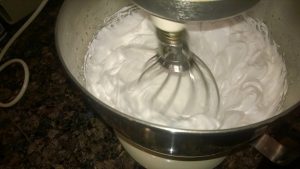 The first thing I tried with it was a chocolate mousse, since the recipe seemed to be on every aquafaba-related website I visited. Sure enough, it tasted only like chocolate mousse, and had that nice, fluffy texture as well.
The first thing I tried with it was a chocolate mousse, since the recipe seemed to be on every aquafaba-related website I visited. Sure enough, it tasted only like chocolate mousse, and had that nice, fluffy texture as well.
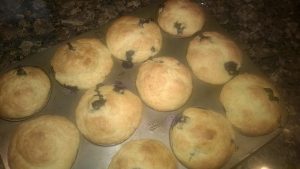 Next I tried a vegan blueberry muffin recipe which also worked quite well. Then, last night I baked a giant meringue which I plan to use to make Eton Mess, a classic British dessert in which meringue is one of the main ingredients. Sadly, aquafaba meringue reacts the same way to humidity as does the egg-white variety, and I now have a somewhat sticky meringue which I will attempt to dry out in a very low oven. But it’s all good since I’m using up something I would ordinarily have tossed. Now I have the opposite problem: what to do with all those chickpeas that I drained! But since it’s summer, how about a salad? This recipe is a great main dish for a steamy day: open a few cans, mix, chill, and eat! Leftovers are tasty, too.
Next I tried a vegan blueberry muffin recipe which also worked quite well. Then, last night I baked a giant meringue which I plan to use to make Eton Mess, a classic British dessert in which meringue is one of the main ingredients. Sadly, aquafaba meringue reacts the same way to humidity as does the egg-white variety, and I now have a somewhat sticky meringue which I will attempt to dry out in a very low oven. But it’s all good since I’m using up something I would ordinarily have tossed. Now I have the opposite problem: what to do with all those chickpeas that I drained! But since it’s summer, how about a salad? This recipe is a great main dish for a steamy day: open a few cans, mix, chill, and eat! Leftovers are tasty, too.
Castilian Salad
1 6-oz can tuna, drained (you can use oil- or water-packed as you prefer)
1 15-oz can chickpeas, drained
1 15-oz can artichoke hearts, drained and quartered
1 cup thinly sliced celery
1/2 cup pimiento-stuffed green olives, halved
2/3 cup creamy Italian dressing mixed with 1 garlic clove, minced
Combine all ingredients in a large bowl. Pour dressing over and mix well. Garnish with wedges of tomato and hard-cooked eggs, if desired. Serve on lettuce leaves if you are feeling fancy.
********************************************************
Interested in reading, cooking and eating? Our Bibliobites Cookbook group returns on September 30th, check it out!





